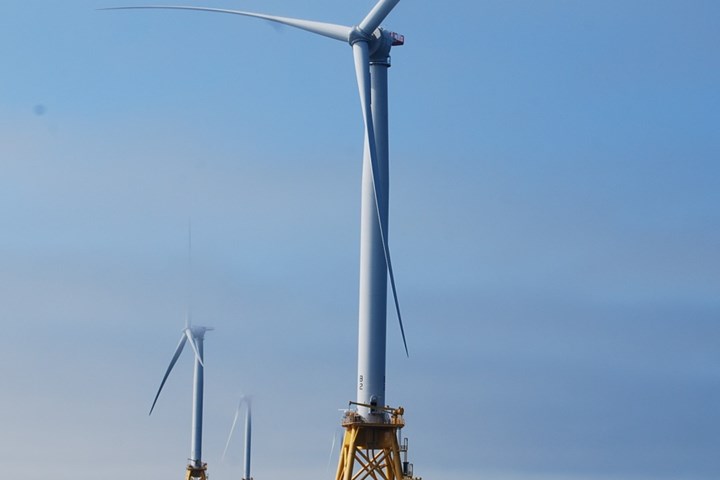U.S. administration announces offshore wind energy auction for the Carolinas
Two lease areas cover 110,091 acres in the Carolina Long Bay, with potential availability of 1.3 GW of offshore wind energy. An auction will be held May 11.
Share
Read Next

Photo Credit: Department of the Interior (DOI)
The U.S. Department of the Interior (Washington, D.C., U.S.) announced that the Bureau of Ocean Energy Management (BOEM) has completed its environmental review and will hold a wind energy auction for two lease areas offshore the Carolinas on May 11, 2022. The lease areas cover 110,091 acres in the Carolina Long Bay area that, if developed, could result in at least 1.3 gigawatts (GW) of offshore wind energy, enough to reportedly power nearly 500,000 homes. The announcement is part of the U.S. administration’s agenda to grow a clean energy economy that harnesses offshore wind projects to strengthen U.S. energy independence, create jobs and lower energy bills for consumers.
The Carolina Long Bay offshore wind energy auction will allow offshore wind developers to bid on one or both of the lease areas within the Wilmington East Wind Energy Area (WEA), as described in BOEM’s Final Sale Notice (FSN), which is available in the Federal Register Reading Room. The two lease areas include similar acreage, distance to shore and wind resource potential.
A recent report indicates that the U.S.’ growing offshore wind energy industry presents a $109 billion revenue opportunity to businesses in the supply chain over the next decade.
The FSN includes several lease stipulations designed to promote the development of a robust domestic U.S. supply chain, advance flexibility in transmission planning and encourage project labor agreements. Among the stipulations announce, BOEM says it will offer a 20% credit to bidders if they commit to invest in programs that will advance U.S. offshore wind energy workforce training or supply chain development.
To advance BOEM’s communication and environmental justice goals, the leases will also require lessees to identify Tribal Nations, underserved communities, agencies, ocean users and other interested stakeholders, and report on their communication and engagement activities with these parties. These stipulations are intended to promote offshore wind energy development in a way that coexists with other ocean uses and protects the ocean environment, while also facilitating the country’s energy future. These innovative stipulations were embraced in the Department’s recent lease sale for the New York Bight, which is said to have set a record as the U.S.’ highest-grossing competitive offshore energy lease sale in history, including oil and gas lease sales.
“BOEM is focused on ensuring that any development offshore North Carolina is done responsibly, in a way that avoids or minimizes potential impacts to the ocean and ocean users in the region,” BOEM director Amanda Lefton notes. “The milestone mark significant progress in achieving this administration’s goal for deploying 30 GW of offshore wind energy by 2030, while creating jobs and strengthening a sustainable domestic supply chain.”
In November 2021, BOEM published a Proposed Sale Notice (PSN) and requested public comments on the proposed leasing of nearly 128,000 acres in the Wilmington East WEA. Based on the bureau’s review of scientific data and extensive input from the commercial fishing industry, Tribes, partnering agencies, key stakeholders and the public, BOEM reduced the acreage available for leasing in the FSN by 14% from the areas proposed in the PSN to avoid conflicts with ocean users and minimize environmental impacts. BOEM will continue to engage with its partners and stakeholders as the process unfolds.
In addition, seven other potential lease sales have been by 2025, including the upcoming Carolina Long Bay lease sale and last month’s New York Bight lease sale. Lease sales offshore California and Oregon, as well as in the Central Atlantic, Gulf of Maine and the Gulf of Mexico are expected to follow.
A recent report indicates that the U.S.’ growing offshore wind energy industry presents a $109 billion revenue opportunity to businesses in the supply chain over the next decade.
More information about the FSN, lease stipulations, the list of qualified bidders for the auction, and auction procedures can be found on BOEM’s Carolina Long Bay website.
Related Content
MingYang reveals 18-MW offshore wind turbine model with 140-meter-long blades
The Chinese wind turbine manufacturer surpasses its 16-MW platform, optimizes wind farm construction costs for 1-GW wind farms.
Read MoreRecycling end-of-life composite parts: New methods, markets
From infrastructure solutions to consumer products, Polish recycler Anmet and Netherlands-based researchers are developing new methods for repurposing wind turbine blades and other composite parts.
Read MoreNovel composite technology replaces welded joints in tubular structures
The Tree Composites TC-joint replaces traditional welding in jacket foundations for offshore wind turbine generator applications, advancing the world’s quest for fast, sustainable energy deployment.
Read MoreInfinite Composites: Type V tanks for space, hydrogen, automotive and more
After a decade of proving its linerless, weight-saving composite tanks with NASA and more than 30 aerospace companies, this CryoSphere pioneer is scaling for growth in commercial space and sustainable transportation on Earth.
Read MoreRead Next
Plant tour: Daher Shap’in TechCenter and composites production plant, Saint-Aignan-de-Grandlieu, France
Co-located R&D and production advance OOA thermosets, thermoplastics, welding, recycling and digital technologies for faster processing and certification of lighter, more sustainable composites.
Read MoreDeveloping bonded composite repair for ships, offshore units
Bureau Veritas and industry partners issue guidelines and pave the way for certification via StrengthBond Offshore project.
Read MoreAll-recycled, needle-punched nonwoven CFRP slashes carbon footprint of Formula 2 seat
Dallara and Tenowo collaborate to produce a race-ready Formula 2 seat using recycled carbon fiber, reducing CO2 emissions by 97.5% compared to virgin materials.
Read More
























